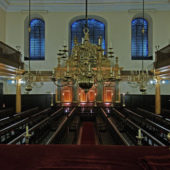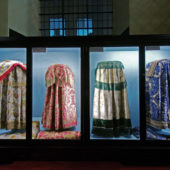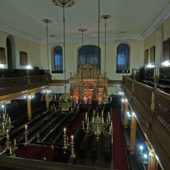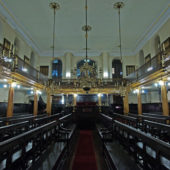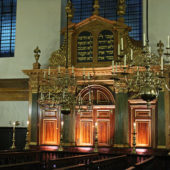Over 300 years old, the United Kingdom’s oldest synagogue is hidden in a courtyard reached through an arched gateway.
In 1290 Jews were expelled from London. Subsequently, in 1656 London’s modern Jewish community began with the famous petition Rabbi Menassah Ben Israel of Holland presented to Oliver Cromwell, who was living in London, with the result that Jews were permitted to live and openly worship in London. A synagogue was rapidly established in a rented house in Creechurch Lane in the City of London, and land was leased at Mile End, Stepney, for a burial ground.
The Sephardic community steadily grew and rapidly outgrew their premises at Creechurch Lane. The site chosen for the new synagogue was sold to the Jewish community by the abbot of Bury St. Edmunds. The Bevis Marks Synagogue was built there and completed in 1701, making it the oldest synagogue in Great Britain still in use. The roof of the synagogue incorporates a beam from a royal ship that was a gift from Queen Anne. The interior of the synagogue was inspired by the great Amsterdam Synagogue, which was built in 1677. The roof was destroyed by a fire in 1738, but repaired in 1749. Other than the roof, the synagogue remains as it was originally built, over 300 years ago.
For over one century, Bevis Marks Synagogue was the center of the religious Anglo-Jewish world, serving as a clearing-house for congregational and individual troubles all over the world; the appeal of the Jamaican Jews for a reduction of taxes in 1736; the internecine quarrel amongst the Jews in Barbados in 1753; and the aiding of seven-year-old Moses de Paz, who escaped from Gibraltar in 1777 to escape forced conversion. As the Sephardic community grew and moved out of the City and East End of London into the West End and suburbs, members demanded that a synagogue be built in the West End. Thus, Bryanstone Street Synagogue was built in 1866. Bevis Marks had formed the seat of the Sephardic community of London up to this time yet the sudden drop in attendance was such that demolition was seriously contemplated (1866). However, the community rallied in support of Bevis Marks Synagogue and it has remained intact to celebrate its bicentenary with great pomp in 1901.
In 1950 the synagogue was recognized as a Grade 1 listed monument of outstanding national importance. In 1992 and 1993 the synagogue suffered serious damage from terrorist bomb attacks levied on the City of London. However, nearly 200,000 British pounds was raised and the synagogue has been in the process of being restored. It is in regular use as a place of worship on the Shabbat (Friday nights and Saturday mornings), Festivals and High Holy Days.
Inside the spacious ivory prayer room of Bevis Marks, large paned arched windows line the side and Eastern walls. Against the Eastern wall is the spectacular Aron Kodesh, hand-carved from oak with the doors grained to imitate mahogany, although its columns and base are painted to look like colored Italian marble. The Renaissance-style carvings are beautifully hand-painted in gold and green. Two large tablets crown the ark, which are inscribed and gilded with the Ten Commandments in Hebrew. The bimah, possibly of a later date, is situated in the center of the sanctuary. The platform is surrounded by a dark, turned wood, balustrade, with entrances on either side. The four front posts hold imposing brass candlesticks to light the reading desk. The tivah (reader’s desk) is placed inside, covered by a blue throw featuring gold embroidery and fringe. Seven hanging multi-armed brass candelabras symbolize the seven days of the week, with the largest, donated by the Great Synagogue in Amsterdam, hanging in the center of the prayer room. The candles in it continue to be lit for weddings and Jewish festivals. The rest of the candelabras were wired for electric lights in 1928. Twelve marble columns, representing the twelve tribes of Israel, support the women’s gallery, which runs along the sides and back of the sanctuary. A wrought iron grill separates the women’s gallery from the sanctuary. Benches sit on wood floors and backless benches, placed at the rear of the prayer room, are from the original synagogue at Creechurch Lane. Recently, Prince Charles attended a service at Bevis Marks. Tony Blair attended the 350th anniversary of the re-settlement of Jews in Great Britain held at Bevis Marks.

